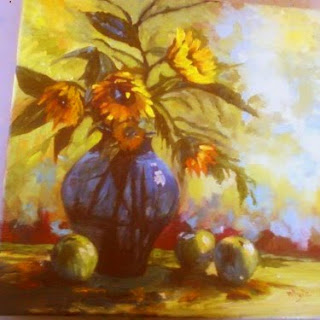 Painting of flowers in Style
Painting of flowers in Style “Painterly” is a word that artists have long used to express the visible brush strokes aparent in a painting. It is the opposite of smooth and blended. It is the opposite of glazing or adding thin veils of color to a painting. To be “painterly” artists like to show their marks, whether made by a brush or a painting knife. To be “painterly” the artist will usually use a more abstract approach allowing colors to blend visually.
To illustrate this I have recently done a number of impressionistic paintings using a technique similar tothe impressionist style of painting. Only instead of using fine dots like the pointillists to convey form and distance, I have endeavored to use small patches of closely analogous color and left the brush marks showing. In other words, very little blending.
To do this I have first premixed several closely related colors in my palette and applied them first with a lot of texture with a filbert brush, and then applying the final stages with a palette/painting knife.Sorry this photo of the painting is not lit well. But I think you can tell by the closeups the colors are much brighter.
Here are some examples close up of the background technique I used. I once had a professor who told me that every square inch of the painting was important…and not to ever think of the background as insignificant! So I have attempted not to neglect the backgrounds!
If you are trying to achieve a painterly style, leaving the background strokes broken and not blended will go a long way to achieving this almost “abstract” style.
I also used the same technique when painting the flowers and the fruit. By adding spots of color and allowing the viewers eye to blend the color instead of my brush I got a loose and attractive result.
As you can also see, edges are left indistinct in many places and background paint was added in negative spaces in some instances after the figure was painted. This also allows the painting to stay “loose” and gives the view the idea without being a slave to details. For this technique, you need to use a LOT of paint. So don’t be chintzy in mixing up your batches of paint…after all, if you use a paint keeper…you can always use the mixes on your next painting. Properly hydrated, both acrylics and water soluble oils will keep quite a while.
I hope you try some of these techniques! Let me know how you fare!
I am to submit a report on this niche your post has been very very helpfull phoenix az painter
ReplyDeleteLovely painting!!!
ReplyDeleteCool Math for kids